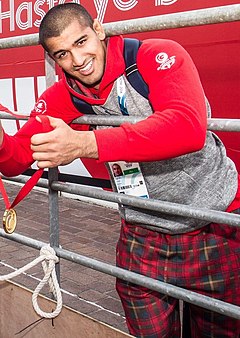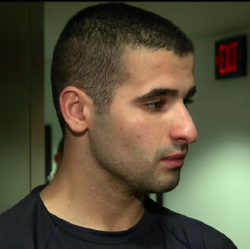Buzz cut
A buzz cut is any of a variety of short hairstyles usually designed with electric clippers. Buzz cut styles include the butch cut, crew cut, flattop, and Ivy League.

Overview
Buzz cuts rose to popularity with the advent of manual hair clippers by the Serbian inventor Nikola Bizumić in the late 19th century.[1] These clippers were widely used by barbers to chop hair close and fast. The clipper accumulates hair in locks to rapidly remove the hair from the head. This type of haircut was normal where strict grooming conventions were in effect.
The top of a buzz cut style may be clipped a uniform short length, producing a butch cut, or into one of several geometric shapes that include the crew cut, flattop, and other short styles. The back and sides are tapered short, semi-short, or medium.[2][3] Buzz cuts can make the face look more defined and are popular with men and boys who want a short, low-maintenance hairstyle, as well as those with thinning or receding hairlines.
In countries such as Australia, China, Russia, the United Kingdom, and the United States, military recruits are given buzz cuts when they enter training; this was originally done to prevent the spread of head lice,[4] but is now done for ease of maintenance, cooling, and uniformity.[5][6]
Gallery
 Randy Orton with a buzz cut
Randy Orton with a buzz cut.jpg) Matt Dumba with a buzz cut
Matt Dumba with a buzz cut Arjun Gill, with a buzz cut
Arjun Gill, with a buzz cut A Naval Academy cadet with a buzz cut
A Naval Academy cadet with a buzz cut Nazem Kadri with a short buzz cut
Nazem Kadri with a short buzz cut Actor Tom Hardy with a buzz cut
Actor Tom Hardy with a buzz cut Wrestler Stardust (Cody Rhodes) with a longer buzz cut
Wrestler Stardust (Cody Rhodes) with a longer buzz cut A politically motivated buzz cut in progress during the Libyan Crisis
A politically motivated buzz cut in progress during the Libyan Crisis
See also
References
- Scali-Sheahan, Maura; Roste, Leslie; Linquest, Linnea; Burness, Amy; Mitchell, Dennis (2017). Milady Standard Barbering (6th ed.). New York City: Cenage Learning. p. 20. ISBN 978-1-305-10055-8
- Victoria Sherrow (2006), Encyclopedia of hair, ISBN 9780313331459
- L.Sherman Trusty (1971). The Art and Science of Barbering. Wolfer Printing Co.
- Stephan Talty (April 19, 1998), "Crew Cuts Forever", The New York Times
- Peter Thompson (February 2003), The Real Insider's Guide to Military Basic Training, Universal-Publishers, ISBN 9781581125979
- The Men 300,000 New Sailors Will Make Navy Their Career Life Oct. 28 1940. Includes photos of WWII Era Navy Induction Crew Cut, Great Lakes Training Center.
External links
